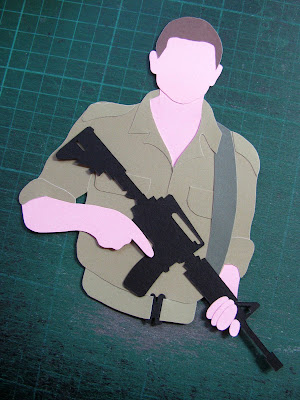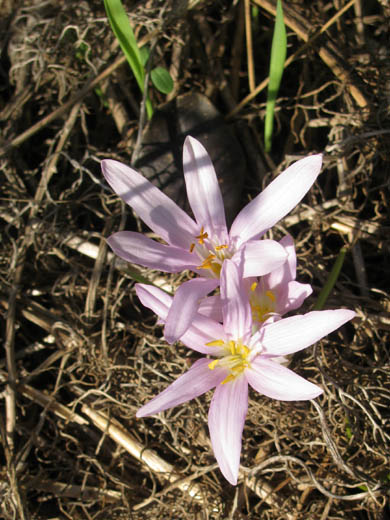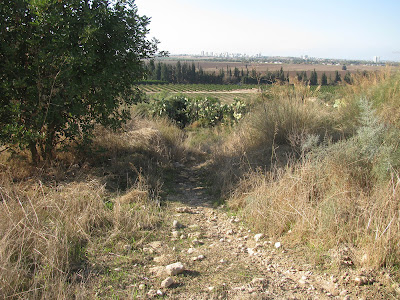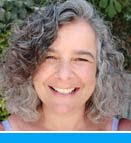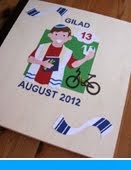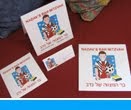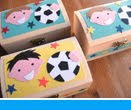The Mrar Hills are situated in the
Shfela (Judaean foothills), south of the city of Rehovot and north of
Gedera. The hills are the fourth and last ridge among the
kurkar (calcareous sandstone) ridges on the southern coastal plain.
Open kurkar areas in Israel are in decline and their rich world of flora
and fauna, some of which are unique to them, are disappearing. Part of the
kurkar ridge in the southern part of the Mrar Hills has been declared a
national park and is maintained by the Nature and Parks Authority.
The Mrar hills rise 94 meters above sea level. In the
Book of Joshua they are defined as a mountain, "Mount Baalah", on the border of the
lands of Dan and Judah. Potsherds from the
Chalcolithic period and burial caves from the Middle Bronze Age and the Roman and
Byzantine periods, above, have been found in the hills, showing that people
have lived in Mrar for many generations.
Some of the caves may have been turned into dwellings or storerooms during the
Ottoman period, when there was a Muslim cave village here. The name Mrar
("caves" in Arabic) shows us the importance of caves to the village.


At the end of the Ottoman period - and to this day - orchards were planted
in the fertile soil that collected in the valleys between the kurkar ridges.
The inhabitants of Mrar Hills had a few water sources, the most important
and dependable of which was the Sorek Stream, which flows from the south.
During the Ottoman period the village had a well and a cistern. The village
also had a controlling view of its surroundings, which gave it a strategic
advantage, an important element in pre-modern times for the development
of a settlement. On the west was the ancient international road connecting
Egypt and Syria (the "Via Maris" or "Way of the Sea"). Another road linked the settlements that developed
to the east. In certain periods an east-west road passed south of the
village, connecting the coastal plain with the Judaean lowlands and the
Jerusalem Mountains.



At the top of the hill are water storage pools built by the Mekorot company as
part of the Yarkon-Negev water line that was established between 1952 and
1955, before construction of the National Water Carrier. Their purpose was to
channel water from the Yarkon Springs to agricultural communities in the
northern Negev.
A statue of a horseman stands nearby as a reminder of the many battles that
have taken place in these hills, before the establishment of the State of
Israel. On 13th November 1917, as part of the battles of the First World War
in Israel, the Battle of the Mrar Hills took place on the ridge. British
forces launched a combined assault, when English cavalry (Yeomanry) and
Scottish infantry fought against 3,000 Ottoman troops and defeated them. The
British forces on their way to Ramle encountered the Ottoman forces occupying
positions in the ridge and nearby villages. At the end of the battle, the
British took control of the main railway junction, with railway lines leading to the south of Israel, and
opened the way to the Jerusalem-Jaffa road. The retreating Ottoman forces lost
hundreds of troops and about a thousand were captured by the British. The
British lost about 500 soldiers.
The Yeomanry charge at these hills, known as
El Mughar Ridge, is considered one of the last cavalry charges in military history.
The agave shrub can be found in several locations on the hills, above. Agave
grows for about 10 years before it blooms, which it only does once in its
lifetime. Before the agave blooms, it produces a long, thick trunk from which
a cluster of thousands of fragrant yellow flowers emerges, which are
pollinated by birds. Arabs customarily plant the agave in cemeteries. Agave
was once grown in Israel to produce fibre and medication, but today it is used
for ornamental purposes only. Other species of agave elsewhere in the world
are cultivated to make sugar and tequila.



On the southeastern fringe of the ridge lay an Arab village called Al-Ma'ar
("The caves"), from which the name of the hills full of kurkar caves was
derived. With the construction of RAF Aqir, which served as the main Royal Air
Force station in Palestine during the Second World War, the importance of the
village increased. At the beginning of the War of Independence, in May 1948, the
village was captured by the IDF. After the war, the newly named
Tel Nof Airbase
became a central base for training the
Paratroopers Brigade. A monument to the
fallen paratroopers in Israel's wars, which we saw at the start of our visit, is located at
Tel Nof, near a site that was once a major paratroopers base.
In 2020, the The Mrar Hills National Park was upgraded. Stairs were built,
paths were paved and signs were set up explaining the landscape, the
vegetation and the battle of the cavalry that took place there. The metal
horseman found his place high up on the ridge.
From the top of the hill
there is a spectacular view of the surrounding settlements: to the southwest
you can see Gedera, to the southeast is
Moshav Beit Elazari, established in
1948 by Jewish immigrants from eastern Europe. You can also see the runway and
hangars of the Tel Nof Air Force Base.
Before returning to our car parked at the paratroopers monument, we stopped for a rest on the grass in front of the monument, above. The
towering pillar of the monument, with parachute wings, is carved with the words of the poet and
Special Operations Executive,
Hannah Szenes, "A voice called to
me - and I went, I went because the voice called." The monument's long stone
wall is inscribed with the biblical verse: "They were swifter than eagles, they were
stronger than lions." (
2 Samuel 1:23). On the wall the names of the paratroopers who fell
from 1949 onward. The monument was built at the initiative of the
paratroopers force and the bereaved families. It was unveiled on 29th October
1960.







